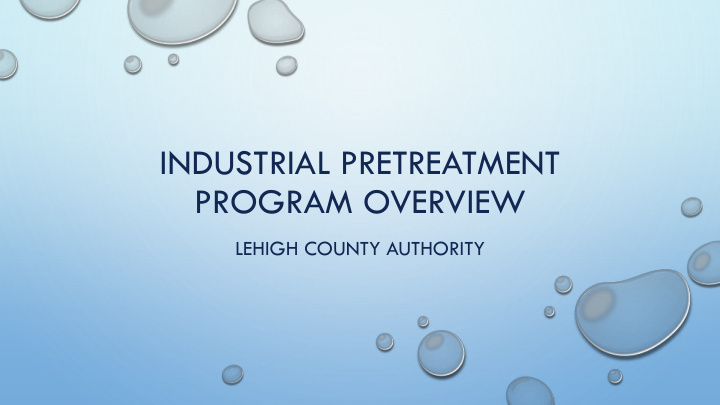



INDUSTRIAL PRETREATMENT PROGRAM OVERVIEW LEHIGH COUNTY AUTHORITY
WHAT IS THE NATIONAL PRETREATMENT PROGRAM? 1970 – EPA created by executive order 1972 – Congress passed the Federal Water Pollution Control Act • Known as the Clean Water Act • NPDES Program created • Direct dischargers 1978 – 40 CFR 403 Established • Indirect discharger regulations • Litigation 1981 – Final regulation
PROGRAM GOALS 40 CFR 403.2 Prevent the introduction of pollutants into a POTW that will • Interfere with the operation of the POTW, including interference with its use or disposal of municipal sludge • Will pass through the treatment works or otherwise be incompatible with such works Improve opportunities to recycle and reclaim municipal and industrial wastewaters and sludges.
CONTROL AUTHORITY EPA POTW IU IU IU
CONTROL AUTHORITY POTW Pretreatment Program requirements Develop and maintain an approved program • Legal authority Evaluate compliance of regulated industrial users Initiate enforcement against industrial users Submit reports to approval authority • Annual pretreatment report Develop local limits (required by the NPDES)
PROHIBITED DISCHARGES General prohibitions • Pass through/Interference Specific prohibitions • Fire/Explosion hazard • Corrosive (<5.0) • Heat (>104°F) • Interference • Oil in amounts that would cause pass through • Hauled pollutants – except in designated locations
INDIRECT DISCHARGERS Industrial Users that discharge to a POTW Regulated through the Pretreatment Program National Pretreatment Program puts most of the responsibility on local municipalities 1,600 POTWs regulating ~23,000 significant users Includes hauled waste
INDUSTRIAL USERS Significant user • More than 25,000 gpd • Subject to categorical standards • Contributes a process stream of >5% of the hydraulic/organic loading of POTW • Reasonable potential to affect the POTW operation Nonsignificant user • Can be categorical if they meet NSCIU requirements
CATEGORICAL USER EPA has established standards for 35 categories for indirect dischargers • 40 CFR Chapter I, Subchapter N, Parts 405-471 Developed for PSES & PSNS LCA currently permits 7 Categorical industries • Metal Finishing (3) • Electrical Components • Pharmaceutical (2) • Coil coating
LCA PRETREATMENT PROGRAM ~ 6,000,000 gallons of industrial waste daily Categorical users • 7 permitted users Nonsignificant categorical users • 3 classified users Significant noncategorical users • 30 permitted users
INDUSTRIAL WASTE PERMITS Duration Discharge limitations • Local limits Ordinance • Categorical standards • Right of entry Sampling requirements/location • Dilution is not acceptable • Violations & penalties Reporting requirements • Criminal & civil liabilities • Self monitoring reports • General prohibitive standards Record keeping Slug/Spill prevention control plan
MONITORING & ENFORCEMENT Self monitoring reports Violation • Frequency • Response with explanation of noncompliance • pH monitoring Significant noncompliance • Flow monitoring • Monetary fine LCA sampling and analyzing • Publication in the newspaper Annual inspection Compliance order • Compliance within certain time Slug report Cease and desist
INDUSTRIAL USER LOCATIONS Kline’s Island WWTP Upper Lower Upper Allentown Emmaus Salisbury Macungie Macungie Milford Categorical – 6 Categorical – 1 SIU - 1 SIU - 1 SIU - 2 SIU - 1 SIU - 11 SIU - 12
LCA PRETREATMENT PROGRAM 466 sampling events that generated over 2,900 laboratory results. 130 Self-Monitoring Reports collected and reviewed 37 Industrial inspections conducted 13 Violations in 2016 2 SNC violations in 2016
HAULED WASTE (ALLENTOWN WWTP) Ordinance - Article 941.3.4 Septic waste only Three haulers accepted 2,067,000 gallons accepted in 2016 Trucks inspected on an annual basis Waste is monitored
Recommend
More recommend